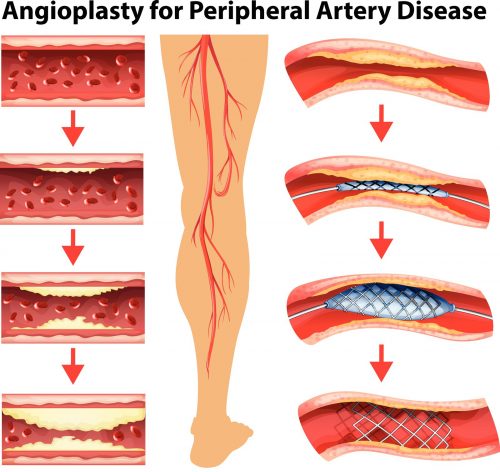Peripheral Angioplasty, Stent and Atherectomy in Lafayette
The medical team at Lafayette Cardiovascular Center of Excellence specializes in the most advanced minimally-invasive treatments available for Peripheral Artery Disease (PAD). Our goal is to prevent unnecessary amputations by restoring blood flow to the affected areas in the lower extremities. These procedures consistently relieve pain, assist with wound healing, improve mobility, and restore sensation.
Percutaneous Transluminal Angioplasty
Percutaneous transluminal angioplasty (PTA) is among the most common treatments for PAD. A catheter is inserted into the affected artery (usually the femoral artery) and is guided to the blockage using advanced X-ray technology. At the site of the blockage, a small balloon on the tip of the catheter is inflated, which pushes the plaque against the artery wall and widens the space for blood to flow. This small balloon may be coated in medicine that helps the artery heal with less scarring. This is called a drug-eluting balloon.
Stent
If your customized treatment plan includes a stent, after the balloon pushes the plaque to the side it then collapses, and a stent is left in place to maintain the necessary space for adequate blood flow. The mesh of the stent may be covered in synthetic fabric along with medicine to assist with healing. This is called a drug-eluting stent.
Atherectomy
Atherectomy is another option commonly performed during percutaneous transluminal angioplasty. During an atherectomy, plaque is removed using either rotational, directional, or laser atherectomy technology.
In some cases, the doctor may determine that a rotational atherectomy is the most appropriate method. It involves using small diamond bits to grind down the plaque into microscopic particles which are disposed of naturally.
During directional atherectomy a small balloon pushes plaque to the side of the vessel and then a small blade removes the plaque from the walls. The plaque particles are stored within the device and removed at the end of the procedure.
During laser atherectomy a small laser is placed on the catheter, which vaporizes the plaque as it tunnels through the blockage.
All of our treatments are completely customized based on your individual needs, determined through the most advanced diagnostic tests available. Say no to amputation! Give us a call or request an appointment today.

